1 of 19
Download to read offline



















Recommended
Arduino-Workshop-4.pptx



Arduino-Workshop-4.pptxHebaEng
╠²
Arduino is a microcontroller board that allows users to create interactive electronic objects and prototypes. It is commonly used by artists, students, and hobbyists to build devices that can sense and control the physical world. The Arduino Uno board contains a microprocessor, memory, and input/output connections that allow it to interface with sensors, LEDs, motors, and other physical computing components. Users write code using the Arduino IDE software to program the board and control the attached devices.Arduino-Workshop-4.pptx



Arduino-Workshop-4.pptxMernitaGavasPalac
╠²
Arduino is a microcontroller board that allows users to create interactive electronic objects and prototypes. It is commonly used by artists, students, and hobbyists to control devices like LED lights or robots. The Arduino Uno board features digital and analog input/output pins that can interface with sensors and actuators. It is programmed using the Arduino IDE software to write codes that can turn pins on/off or monitor pin states.VERY NICE FOR CSE 3RD YEAR AND IOT STUDENTS



VERY NICE FOR CSE 3RD YEAR AND IOT STUDENTSneelamsanjeevkumar
╠²
VERY NICE FOR CSE 3RD YEAR AND IOT STUDENTS Arduino intro.pptx



Arduino intro.pptxAlexRiv4
╠²
This document provides an introduction to Arduino, including:
- What Arduino is and its uses for artists, students, and hobbyists.
- That Arduino is a microcontroller board based on the ATmega328 chip, which has 32KB of flash memory, 2KB of SRAM, and 1KB of EEPROM.
- Different types of Arduino boards like Uno, Mega, LilyPad, and DIY boards.
- How to code for Arduino using the Arduino IDE software, by selecting the correct board and port and uploading programs.
- Key concepts like digital and analog I/O, if-statements, and serial communication.MICROCONTROLLER BASED SYSTEM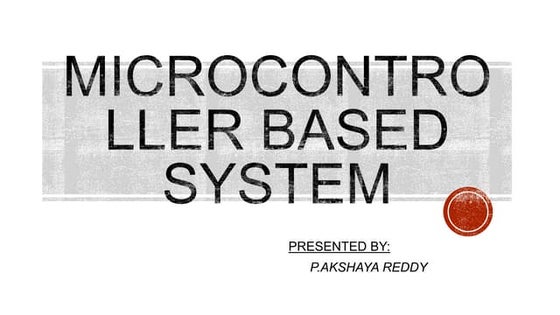



MICROCONTROLLER BASED SYSTEMSrinivasGurijala4
╠²
An Arduino is a microcontroller board that can be programmed to sense the environment using inputs like sensors, control actuators like motors with outputs, and communicate using protocols like I2C and USB. It contains everything needed to support the microcontroller chip including power, memory, and input/output interfaces. The Arduino IDE software is used to write programs which are then compiled and loaded onto the board via a USB cable to be executed.micocontolle based stem in the age of lton



micocontolle based stem in the age of ltonAbhinavGurijala
╠²
micocontolle based stem in the age of lton WeMos D1 Mini with integrated ESP8266 has an operating



WeMos D1 Mini with integrated ESP8266 has an operatingAbhinavGurijala
╠²
WeMos D1 Mini with integrated ESP8266 has an operating varduino uno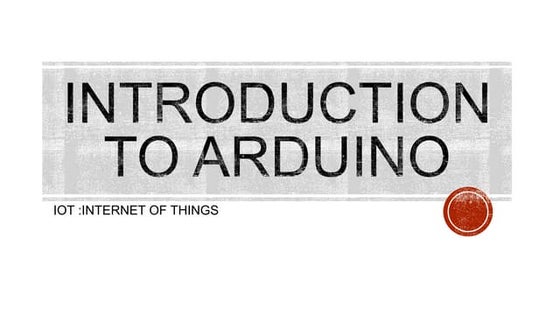



arduino uno20PA013BHOOMIKAP
╠²
This document provides an overview of the Arduino Uno microcontroller board. It describes that the Arduino Uno contains an ATmega328 microprocessor and can be used to control electronics projects through input and output pins. The Arduino IDE software is used to write programs that can be compiled and uploaded to the board via a USB connection. The document explains the different pin types on the Arduino Uno and provides examples of how sensors and actuators can be connected to collect analog and digital data and control outputs.P.Akshaya reddy.pptx



P.Akshaya reddy.pptxSrinivasGurijala4
╠²
A microcontroller is a small computer integrated circuit that contains a CPU, memory, and input/output peripherals. The Arduino Uno is a popular microcontroller board based on the ATmega328 microcontroller chip. It contains digital and analog pins that allow it to control electronics projects and communicate with a computer through a USB connection or external power supply. The Arduino IDE software is used to write programs and upload them to the Arduino board.Microcontroller based system Babc.pptx



Microcontroller based system Babc.pptxAbhinavGurijala
╠²
This document provides an introduction to programming the ESP8266 WiFi chip. It outlines ESP8266 basics, including an overview of the ESP-01What is Arduino ?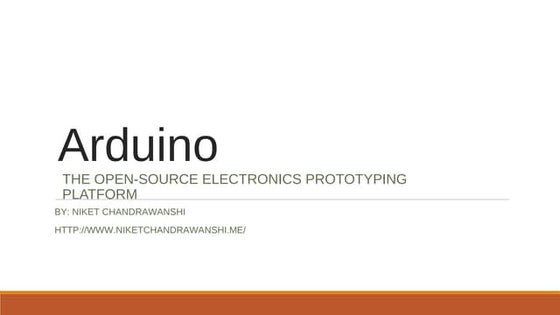



What is Arduino ?Niket Chandrawanshi
╠²
The document discusses the Arduino open-source electronics prototyping platform. It describes what Arduino is, its programming environment, advantages, features, applications, and how it compares to other prototyping platforms. Arduino is an affordable and easy to use platform for creating interactive electronic projects through an open-source hardware board and software. It allows users to prototype sensors and control devices through code.Embedded system application



Embedded system applicationDhruwank Vankawala
╠²
The document provides information about interfacing an RF transmitter module with an Arduino board. It includes the technical specifications of the RF transmitter and receiver modules. The circuit diagram shows how to connect the RF transmitter module to an Arduino board. It also includes the Arduino code for the RF transmitter to send digital signals and the RF receiver code to receive the signals and control an LED accordingly.Arduino workshop



Arduino workshopmayur1432
╠²
The document discusses the Arduino board, which was created in 2005 in Italy as an open source hardware platform. It can be programmed using C/C++ and other languages to read analog/digital signals and control outputs. The Arduino Uno was released in 2011 and contains an ATmega328p microcontroller, 14 digital I/O pins (6 provide PWM), 6 analog inputs, and operates at 16MHz. Example projects shown include an LED cube, fan control, and more. The Arduino IDE is used for coding the board using setup() and loop() functions. Digital and analog I/O, serial communication, and other concepts are explained.What are the different types of arduino boards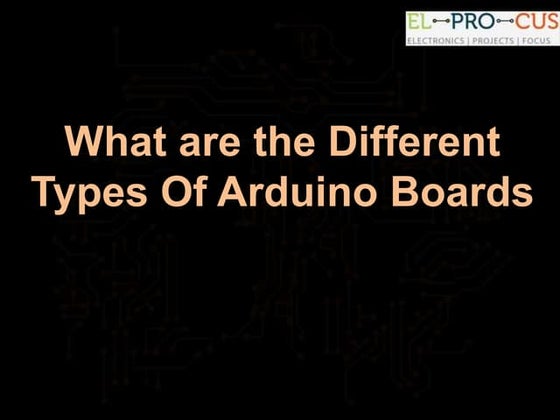



What are the different types of arduino boardselprocus
╠²
This article discusses about different types of Arduino boards includes the Arduino UNO (R3), LilyPad, Red Board, Arduino Mega (R3), Arduino LeonardoArduino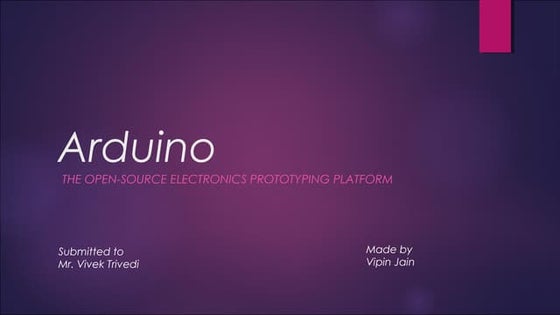



Arduinovipin7vj
╠²
The document discusses the Arduino, an open-source electronics prototyping platform. It provides a brief history of how Arduino was created in 2005 to provide an affordable platform for interactive design projects. It describes the key features of the Arduino Uno board and the Arduino programming environment. Finally, it outlines some common applications of Arduino in fields like home automation, robotics, and sensor prototyping.Arduino slides



Arduino slidessdcharle
╠²
The document provides an overview of Arduino, including what it is, common Arduino boards, digital and analog input/output, and example projects. Arduino is an open-source electronics prototyping platform that can be used to create interactive objects. It uses a simple hardware and software environment to program and develop prototypes. The Arduino Uno is one of the most commonly used boards, which contains an Atmega328 microcontroller, digital and analog pins, and can be programmed via USB. The document describes how to connect various components like LEDs, buttons, sensors and motors to an Arduino board.Arduino Workshop ║▌║▌▀Żs



Arduino Workshop ║▌║▌▀Żsmkarlin14
╠²
The document provides an overview of Arduino, including what it is, common Arduino boards, digital and analog input/output, and example projects. Arduino is an open-source electronics prototyping platform that allows users to create interactive objects and environments. It uses flexible, easy-to-use hardware and software. Common tasks demonstrated include blinking LEDs, reading buttons, and controlling motors. The document serves as an introduction to getting started with the Arduino platform.Intro arduino



Intro arduinoMaLcom MooNwalker
╠²
The document introduces the Arduino microcontroller board. It describes the Arduino as an easy-to-use and inexpensive platform for physical computing. Key components of the Arduino include an ATmega328P microcontroller, digital and analog input/output pins, a USB connection for programming, and a standard pin layout that allows connection of expansion boards. The document provides an overview of the Arduino's capabilities and use in interactive projects.Ardunio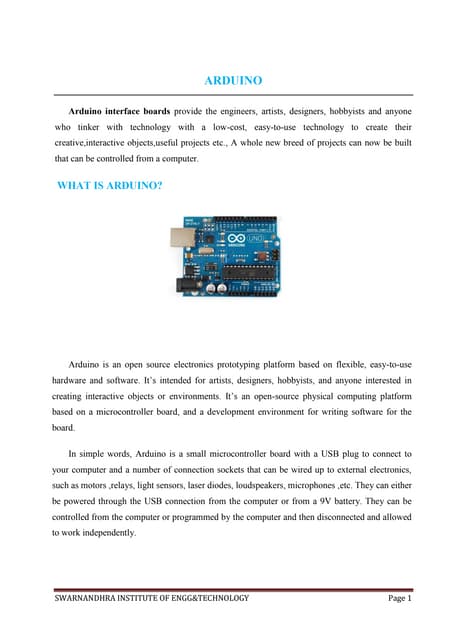



ArdunioDILEEP KUMAR
╠²
The document provides information about how the Arduino board works. It explains that the Arduino uses an Atmega microcontroller chip which is programmed to control inputs and outputs. A secondary chip, such as an Atmega8U2, handles the USB connection and communication between the microcontroller and computer. Supporting components like voltage regulators, capacitors, crystals and resistors work together to power the chips safely and generate the clock signal needed for programming and operation.Intro to arduino



Intro to arduinoJos├® Faria
╠²
The document provides an overview introduction to the Arduino microcontroller development board. It describes what an Arduino is, discusses different types of Arduino boards including the common Arduino Uno, explains the features of the Arduino Uno, and gives instructions on downloading the Arduino IDE software and plugging in an Arduino board to begin programming.Ardu



ArduDheeraj Sagar
╠²
This document provides an overview of Arduino, an open-source electronics platform. It discusses that Arduino boards can read inputs like light or buttons and turn them into outputs like activating motors or LEDs. The Arduino programming language and IDE make it easy to write code and upload it to the board. A basic blink program is presented as an example. Key features of the Arduino UNO board are listed, including the microcontroller, memory, and input/output pins. Common applications of Arduino in robotics and IoT are mentioned, such as motion detectors and home automation.ARDUINO OVERVIEW HARDWARE SOFTWARE AND INSTALLATION.pptx



ARDUINO OVERVIEW HARDWARE SOFTWARE AND INSTALLATION.pptxmenchc1207
╠²
The document provides an overview of the Arduino hardware and software platform. It discusses that Arduino is an open-source electronics platform that can read inputs and turn them into outputs. Some common Arduino boards are then described, including the Arduino UNO, Nano, Leonardo, and Micro. The Arduino UNO is highlighted as one of the most popular boards due to its extensive documentation and tutorials available. The key components of the Arduino UNO board are then outlined.Microcontroller based system amonG.pptx



Microcontroller based system amonG.pptxAbhinavGurijala
╠²
This document provides an introduction to programming the ESP8266 WiFi chip. It outlines ESP8266 basics, including an overview of the ESP-01This document provides an introduction to programming the ESP8266 WiFi chip. It outlines ESP8266 basics, including an overview of the ESP-01Proposal Report on Auto Meter Reading



Proposal Report on Auto Meter ReadingRebekahSamuel2
╠²
The document proposes a solution to automate electricity meter reading in Pakistan using Arduino technology. An Arduino chip would be installed inside each electricity meter and connected to a 4G shield. The Arduino would record consumption data and transmit it via the 4G shield to a WAPDA server. This would allow remote meter reading and billing, reducing costs compared to the current manual process.TECH TALK-4TH SEM.pptx the arduino haha



TECH TALK-4TH SEM.pptx the arduino hahagokulprasanna4
╠²
The document presents an overview of Arduino. It defines Arduino as an open-source physical computing platform using a simple input/output board and Processing/Wiring language development environment. It describes common Arduino boards like Uno, Mega 2560, and Duemilanove. Features of the Arduino Uno are outlined, including basic terminology in Arduino like analog to digital conversion and pulse width modulation. Examples of interfacing Arduino with DC motors and RC car motors are provided. The document concludes with advantages of Arduino like low cost and cross-platform IDE.More Related Content
Similar to Arduino-Workshop For beginners UG Students (20)
arduino uno



arduino uno20PA013BHOOMIKAP
╠²
This document provides an overview of the Arduino Uno microcontroller board. It describes that the Arduino Uno contains an ATmega328 microprocessor and can be used to control electronics projects through input and output pins. The Arduino IDE software is used to write programs that can be compiled and uploaded to the board via a USB connection. The document explains the different pin types on the Arduino Uno and provides examples of how sensors and actuators can be connected to collect analog and digital data and control outputs.P.Akshaya reddy.pptx



P.Akshaya reddy.pptxSrinivasGurijala4
╠²
A microcontroller is a small computer integrated circuit that contains a CPU, memory, and input/output peripherals. The Arduino Uno is a popular microcontroller board based on the ATmega328 microcontroller chip. It contains digital and analog pins that allow it to control electronics projects and communicate with a computer through a USB connection or external power supply. The Arduino IDE software is used to write programs and upload them to the Arduino board.Microcontroller based system Babc.pptx



Microcontroller based system Babc.pptxAbhinavGurijala
╠²
This document provides an introduction to programming the ESP8266 WiFi chip. It outlines ESP8266 basics, including an overview of the ESP-01What is Arduino ?



What is Arduino ?Niket Chandrawanshi
╠²
The document discusses the Arduino open-source electronics prototyping platform. It describes what Arduino is, its programming environment, advantages, features, applications, and how it compares to other prototyping platforms. Arduino is an affordable and easy to use platform for creating interactive electronic projects through an open-source hardware board and software. It allows users to prototype sensors and control devices through code.Embedded system application



Embedded system applicationDhruwank Vankawala
╠²
The document provides information about interfacing an RF transmitter module with an Arduino board. It includes the technical specifications of the RF transmitter and receiver modules. The circuit diagram shows how to connect the RF transmitter module to an Arduino board. It also includes the Arduino code for the RF transmitter to send digital signals and the RF receiver code to receive the signals and control an LED accordingly.Arduino workshop



Arduino workshopmayur1432
╠²
The document discusses the Arduino board, which was created in 2005 in Italy as an open source hardware platform. It can be programmed using C/C++ and other languages to read analog/digital signals and control outputs. The Arduino Uno was released in 2011 and contains an ATmega328p microcontroller, 14 digital I/O pins (6 provide PWM), 6 analog inputs, and operates at 16MHz. Example projects shown include an LED cube, fan control, and more. The Arduino IDE is used for coding the board using setup() and loop() functions. Digital and analog I/O, serial communication, and other concepts are explained.What are the different types of arduino boards



What are the different types of arduino boardselprocus
╠²
This article discusses about different types of Arduino boards includes the Arduino UNO (R3), LilyPad, Red Board, Arduino Mega (R3), Arduino LeonardoArduino



Arduinovipin7vj
╠²
The document discusses the Arduino, an open-source electronics prototyping platform. It provides a brief history of how Arduino was created in 2005 to provide an affordable platform for interactive design projects. It describes the key features of the Arduino Uno board and the Arduino programming environment. Finally, it outlines some common applications of Arduino in fields like home automation, robotics, and sensor prototyping.Arduino slides



Arduino slidessdcharle
╠²
The document provides an overview of Arduino, including what it is, common Arduino boards, digital and analog input/output, and example projects. Arduino is an open-source electronics prototyping platform that can be used to create interactive objects. It uses a simple hardware and software environment to program and develop prototypes. The Arduino Uno is one of the most commonly used boards, which contains an Atmega328 microcontroller, digital and analog pins, and can be programmed via USB. The document describes how to connect various components like LEDs, buttons, sensors and motors to an Arduino board.Arduino Workshop ║▌║▌▀Żs



Arduino Workshop ║▌║▌▀Żsmkarlin14
╠²
The document provides an overview of Arduino, including what it is, common Arduino boards, digital and analog input/output, and example projects. Arduino is an open-source electronics prototyping platform that allows users to create interactive objects and environments. It uses flexible, easy-to-use hardware and software. Common tasks demonstrated include blinking LEDs, reading buttons, and controlling motors. The document serves as an introduction to getting started with the Arduino platform.Intro arduino



Intro arduinoMaLcom MooNwalker
╠²
The document introduces the Arduino microcontroller board. It describes the Arduino as an easy-to-use and inexpensive platform for physical computing. Key components of the Arduino include an ATmega328P microcontroller, digital and analog input/output pins, a USB connection for programming, and a standard pin layout that allows connection of expansion boards. The document provides an overview of the Arduino's capabilities and use in interactive projects.Ardunio



ArdunioDILEEP KUMAR
╠²
The document provides information about how the Arduino board works. It explains that the Arduino uses an Atmega microcontroller chip which is programmed to control inputs and outputs. A secondary chip, such as an Atmega8U2, handles the USB connection and communication between the microcontroller and computer. Supporting components like voltage regulators, capacitors, crystals and resistors work together to power the chips safely and generate the clock signal needed for programming and operation.Intro to arduino



Intro to arduinoJos├® Faria
╠²
The document provides an overview introduction to the Arduino microcontroller development board. It describes what an Arduino is, discusses different types of Arduino boards including the common Arduino Uno, explains the features of the Arduino Uno, and gives instructions on downloading the Arduino IDE software and plugging in an Arduino board to begin programming.Ardu



ArduDheeraj Sagar
╠²
This document provides an overview of Arduino, an open-source electronics platform. It discusses that Arduino boards can read inputs like light or buttons and turn them into outputs like activating motors or LEDs. The Arduino programming language and IDE make it easy to write code and upload it to the board. A basic blink program is presented as an example. Key features of the Arduino UNO board are listed, including the microcontroller, memory, and input/output pins. Common applications of Arduino in robotics and IoT are mentioned, such as motion detectors and home automation.ARDUINO OVERVIEW HARDWARE SOFTWARE AND INSTALLATION.pptx



ARDUINO OVERVIEW HARDWARE SOFTWARE AND INSTALLATION.pptxmenchc1207
╠²
The document provides an overview of the Arduino hardware and software platform. It discusses that Arduino is an open-source electronics platform that can read inputs and turn them into outputs. Some common Arduino boards are then described, including the Arduino UNO, Nano, Leonardo, and Micro. The Arduino UNO is highlighted as one of the most popular boards due to its extensive documentation and tutorials available. The key components of the Arduino UNO board are then outlined.Microcontroller based system amonG.pptx



Microcontroller based system amonG.pptxAbhinavGurijala
╠²
This document provides an introduction to programming the ESP8266 WiFi chip. It outlines ESP8266 basics, including an overview of the ESP-01This document provides an introduction to programming the ESP8266 WiFi chip. It outlines ESP8266 basics, including an overview of the ESP-01Proposal Report on Auto Meter Reading



Proposal Report on Auto Meter ReadingRebekahSamuel2
╠²
The document proposes a solution to automate electricity meter reading in Pakistan using Arduino technology. An Arduino chip would be installed inside each electricity meter and connected to a 4G shield. The Arduino would record consumption data and transmit it via the 4G shield to a WAPDA server. This would allow remote meter reading and billing, reducing costs compared to the current manual process.TECH TALK-4TH SEM.pptx the arduino haha



TECH TALK-4TH SEM.pptx the arduino hahagokulprasanna4
╠²
The document presents an overview of Arduino. It defines Arduino as an open-source physical computing platform using a simple input/output board and Processing/Wiring language development environment. It describes common Arduino boards like Uno, Mega 2560, and Duemilanove. Features of the Arduino Uno are outlined, including basic terminology in Arduino like analog to digital conversion and pulse width modulation. Examples of interfacing Arduino with DC motors and RC car motors are provided. The document concludes with advantages of Arduino like low cost and cross-platform IDE.More from Godwin585235 (10)
digita circuit design.pptx



digita circuit design.pptxGodwin585235
╠²
This document provides an overview of digital circuit design and its key components. It begins with an introduction to logic gates such as AND, OR, NOT, NAND, NOR, and XOR gates. Next, it covers Boolean algebra and map simplification techniques. It then discusses combinational circuits like multiplexers, demultiplexers, encoders, and decoders. The document proceeds to explain sequential circuits like flip-flops, including SR, D, JK, and T flip-flops. It concludes with a brief overview of sequential circuits and their use of flip-flops as state memory elements.java01.ppt



java01.pptGodwin585235
╠²
This document provides an introduction to the Java programming language. It discusses Java's object-oriented nature and platform independence. It explains how to write standalone Java programs and applets that can run in web browsers. It also covers Java's virtual machine, data types, control structures, classes and objects. Examples are provided of "Hello World" programs and basic class definitions.PCB Tutorial.pptx



PCB Tutorial.pptxGodwin585235
╠²
This document provides instructions for designing a printed circuit board (PCB) using Altium software. It describes the key steps which include:
1) Deciding on the functionality needed and choosing components to implement those functions
2) Creating a system schematic by placing components and wiring them together
3) Designing the PCB layout by placing components, routing traces between them, and using techniques like polygon pours ch02.ppt



ch02.pptGodwin585235
╠²
Digital Design
Copyright ┬® 2006
Frank Vahid
1. This document discusses combinational logic design and covers topics such as Boolean algebra, logic gates, truth tables, and the process for designing combinational logic circuits.
2. It provides examples of different representations of Boolean functions including equations, truth tables, and logic gate diagrams. Properties of Boolean algebra are also covered.
3. The three step process for combinational logic design is outlined as 1) capture the function, 2) convert to equations, and 3) implement as a gate-based circuit. An example of designing a circuit to count the number of 1s on three inputs is provided.cyber secuirty.pptx



cyber secuirty.pptxGodwin585235
╠²
Cyber security involves protecting computers, networks, programs and data from unauthorized access and cyber attacks. It aims to ensure confidentiality, integrity and availability of information. Key aspects of cyber security include authentication, authorization, network security, application security and information security. Authentication verifies a user's identity, while authorization determines their access privileges. Cyber threats can include cyber attacks, exploits, vulnerabilities and data breaches. Mitigation strategies and software patches help reduce damage from security incidents.ROBOTICS APPLICATIONS.pptx



ROBOTICS APPLICATIONS.pptxGodwin585235
╠²
This document discusses robots, including their definition, laws of robotics, and various uses. It describes robots as machines that can be controlled by computers to perform human tasks. The three laws of robotics are that robots may not harm humans, must obey human orders unless it conflicts with the first law, and must protect their own existence unless it conflicts with the first two laws. The document then lists several applications of robotics in areas like agriculture, automobiles, healthcare, military, space exploration, construction, and more. It provides examples of how robots are used for industrial tasks like material handling, assembly, and inspection. In conclusion, the document notes that most robots currently work in industries and factories to help businesses operate more efficiently.Presentation On Machine Learning.pptx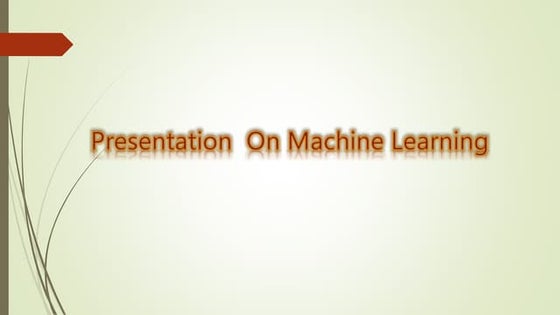



Presentation On Machine Learning.pptxGodwin585235
╠²
This document provides an overview of machine learning, including its history, definitions, applications, and algorithms. It discusses how machine learning involves computers acquiring knowledge from empirical data to evolve behaviors. Key aspects covered include the learning system model of input/training/testing, factors that affect performance such as the learning algorithms used, and examples of different algorithm types like supervised and unsupervised learning. The document concludes that machine learning will become increasingly important in daily life as more techniques are developed.Recently uploaded (20)
Expert Odoo support services (1).pdf



Expert Odoo support services (1).pdfdela33martin33
╠²
SDLC Corp offers Odoo Support Service, ensuring seamless business operations with expert assistance. Our Odoo ERP Support Services ance performance, while Odoo Technical Support resolves issues enhance efficiently, optimizing workflows, improving system reliability, and boosting productivity for long-term success.Microsoft Azure: Empowering the Future of Cloud Technology



Microsoft Azure: Empowering the Future of Cloud Technologycyberpoint678
╠²
Microsoft Azure is a leading cloud computing platform offering scalable solutions for businesses and developers. It provides services like AI, analytics, security, and hybrid cloud capabilities. Azure enables seamless app deployment, data management, and machine learning, ensuring reliability and innovation. With global infrastructure and advanced tools, Azure accelerates digital transformation for enterprises of all sizes.
For More: https://cyberpoint.com.au/it-services/cloud-computing-overview/microsoft-azure/Odoo Project Management .pdf



Odoo Project Management .pdfdela33martin33
╠²
SDLC Corp delivers a powerful Odoo Project Management solution, offering seamless Odoo project module implementation, automation, and customization. Our Odoo project management software optimizes workflows, enhances collaboration, and ensures efficient project execution for business growth and scalability.Odoo Migration Services-1 .pdf



Odoo Migration Services-1 .pdfdela33martin33
╠²
Collaborate with SDLC Corp for expert Odoo Migration Services, enhancing business automation and efficiency through seamless Odoo Data Migration. Our tailored solutions support decision-making by optimizing workflows, ensuring operational excellence and driving sustainable growth. Partner with a trusted Odoo Migration Company for personalized migration experiences.ESTUDO DO ARTIGO 22 AO 39 DO C├ōDIGO C├ŹVIL.pdf



ESTUDO DO ARTIGO 22 AO 39 DO C├ōDIGO C├ŹVIL.pdfHELLEN CRISTINA
╠²
ESTUDO DO ARTIGO 22 AO 39 DO C├ōDIGO C├ŹVIL
COM BASE NO ENTENDIMENTO DOS ARTIGOS, ESCOLHER UMA
DOUTRINA E FAZER UM RESUMO SOBRE
MANUSCRITO
4 LAUDAS NO M├ŹNIMO
PRECISANDO DE AJUDA COą£
TRABALHOS ACAD├ŖMICOS?
DH ASSESSORIA ACADEMBGP Best Practices, presented by Imtiaz Sajid



BGP Best Practices, presented by Imtiaz SajidAPNIC
╠²
Imtiaz Sajid, Network Analyst / Technical Trainer at APNIC, delivered a remote presentation on 'BGP Best Practices' for MMNOG 7 held Yangon, Myanmar from 19 to 22 March 2025. Shopify Store Setup_ Database Management for Large Stores.pdf



Shopify Store Setup_ Database Management for Large Stores.pdfCartCoders
╠²
Discover expert Shopify store setup services with CartCoders. Tailored to meet your unique business needs, our team ensures your online store launches smoothly with all necessary features. Maximize your e-commerce potential with our professional support and guidance.PresentWEFWEFWERWERWERWERREWREWation.pptx



PresentWEFWEFWERWERWERWERREWREWation.pptxtoxicsuprit
╠²
ewfweqrwqerwrwqrwqr qwr qw r qwrqwrqwrqw rqwrqwr qwrq wr wqr qwrfdwqf qw f qwf qw r qw f qw f qwf qw fqw r q2wr q3 32 r qwf qw f as f werweqt we fr ewf we fw qe fw egew g we g ewg ew ewg weg w eg we g ewg we g ewewExpert Odoo Support Services .pdf



Expert Odoo Support Services .pdfdela33martin33
╠²
SDLC Corp offers Odoo Support Service, ensuring seamless business operations with expert assistance. Our Odoo ERP Support Services enhance performance, while Odoo Technical Support resolves issues efficiently, optimizing workflows, improving system reliability, and boosting productivity for long-term success.Odoo demo .pdf



Odoo demo .pdfdela33martin33
╠²
SDLC Corp offers comprehensive and personalized Odoo Demo services, helping businesses explore the full potential of Odoo ERP Our Odoo experts provide hands-on demos of core Odoo modules such as CRM, Sales, Inventory, Accounting, and more. As a trusted Odoo partner, we ensure you experience real-time workflows and tailored functionalities. From customization to integration, we help you make informed decisions with an interactive Odoo demo that highlights efficiency, automation, and business growth opportunities.Hire Odoo Consultant .pdf



Hire Odoo Consultant .pdfdela33martin33
╠²
SDLC Corp provides expert Odoo consulting services, helping businesses streamline operations, customize ERP solutions, and enhance efficiency. Our Odoo consultants specialize in implementation, integration, and support, ensuring seamless Odoo services that optimize workflows, boost productivity, and drive business growth.Generative artificial intelligence in EU Grant Writing



Generative artificial intelligence in EU Grant WritingPeter Trkman
╠²
The presentation "AI in EU Grant Writing" by Dr. Peter Trkman and Dr. Luka Tomat focuses on the integration of generative artificial intelligence (GenAI) tools into the process of writing grant applications, particularly in the context of EU-funded projects. It was delivered as part of a workshop held at the University of Ljubljana and is based on the authorsŌĆÖ extensive experienceŌĆöover 80 workshops since late 2023.
The presentation begins by clarifying what GenAI is and what it is not. It explains how large language models (LLMs) work, including tokenization, vector embedding, and self-attention mechanisms. It introduces major LLMs such as GPT-4, Claude, Grok, Gemini, and others, along with an extensive list of tools built on top of these models.
The core of the presentation is practical. It explores how GenAI can assist in the preparation of grant applications, from generating project summaries and activity plans to producing ethics statements and evaluation responses. Concrete examples are given from Erasmus+ mobility forms, national project applications, and fictional debates using actual EU evaluation criteria.
The authors explain that GenAI is most useful for tasks requiring large volumes of content, knowledge synthesis, translation to various audiences, second opinions, and early drafting. However, they emphasize that it should not be used when accuracy is paramount or when ethical implications are significant. Instead, it is best seen as a complementary tool that boosts productivity, especially for those less experienced in writing.
The presentation includes broader reflections on how GenAI is reshaping research practices and the labor market, with references to studies showing that GenAI often outperforms human analysts in certain tasks and that its emotional support capabilities rival those of trained therapists.
Specific tools for grant writing are introduced, such as DeepRFP, Grantable, and GrantedAI, along with general tools like ChatGPT, Copilot, and Perplexity. The presenters also advocate for long-term structural change in the grant systemŌĆöstreamlining processes to eliminate the need for GenAI use altogether. Until then, they argue, one must ŌĆ£play the gameŌĆØ and use these tools effectively while maintaining academic integrity.
The closing message is clear: while GenAI tools offer powerful support, responsible use and a focus on substance over form remain essential. Peter and Luka invite further contact for tailored workshops and note that all content is based on their personal experience and research, not confidential material.The Evolution of Home Security from Cameras to Smart Systems.pdf



The Evolution of Home Security from Cameras to Smart Systems.pdfInternet Bundle Now
╠²
Explore how Home Security Cameras evolved into intelligent, connected systems. Internet Bundle Now breaks down the rise of Home Security Services.
Complete Nmap Scanning Commands CheatSheet by Hackopedia Utkarsh Thakur



Complete Nmap Scanning Commands CheatSheet by Hackopedia Utkarsh ThakurHackopedia Utkarsh Thakur
╠²
Complete Nmap Scanning Commands CheatSheet by Hackopedia Utkarsh Thakur, ETHICAL HACKING , HACKOPEDIA ¤öź SITUS GACOR TERPERCAYA - KAJIAN4D! ¤öź



¤öź SITUS GACOR TERPERCAYA - KAJIAN4D! ¤öźKAJIAN4D
╠²
¤öź SITUS GACOR TERPERCAYA - KAJIAN4D! ¤öź
¤Æ░ BONUS MELIMPAH UNTUK MEMBER BARU & SETIA! ¤Æ░
Ō£ģ Bonus New Member 50% (Pragmatic)
Ō£ģ Bonus New Member 20% (PG Soft)
Ō£ģ Bonus Deposit 10%
Ō£ģ Bonus Lucky Spin 500K
ŌÜĪ DEPOSIT KILAT HITUNGAN DETIK! ŌÜĪ
¤ÆĖ Proses cepat & aman dengan sistem QRIS!
¤ÜĆ DAFTAR SEKARANG & RAIH KEMENANGANMU! ¤ÜĆ
¤öŹ GOOGLE: KAJIAN4D
¤ōī Mainkan game favoritmu dan nikmati keseruannya bersama KAJIAN4D!Arduino-Workshop For beginners UG Students
- 2. Pune Makers ( http://www.meetup.com/Pune-Makers/ ) 2 ARDUINO ’é¦ Arduino is the go-to gear for artists, hobbyists, students, and anyone with a gadgetry dream. ’é¦ Arduino rose out of another formidable challenge: how to teach students to create electronics, fast. ’é¦ With Arduino, you can control almost everything around you be it simple LED or giant Robots.
- 3. Pune Makers ( http://www.meetup.com/Pune-Makers/ ) 3 ARDUINO ’é¦ Basically Arduino is Microcontroller. ’é¦ Microcontroller is microprocessor with memory, RAM and some other peripheral connected with it. ’é¦ The Arduino Uno is a microcontroller board based on the ATmega328 . The ATmega328 has Flash memory of 32 KB (with 0.5 KB used for the bootloader). It also has 2 KB of SRAM and 1 KB of EEPROM
- 4. Pune Makers ( http://www.meetup.com/Pune-Makers/ ) 4 DIFFERENT TYPES OF ARDUINO Arduino Mega 2560 Arduino LilyPad Arduino Uno DIY Arduino Boarduino Kit
- 5. Pune Makers ( http://www.meetup.com/Pune-Makers/ ) 5 ARDUINO UNO ’é¦ What does it have? ’é¦ 14 Digital In/Out pins (6 can be used as PWM) ’é¦ 6 Analog Inputs ’é¦ A USB Connection ’é¦ A Power Jack ’é¦ Reset Button ’é¦ On-board LED ’é¦ SCL/SDA pins (Serial Clock/ Serial Data pins) ’é¦ In short, it contains everything needed to support the microcontroller; simply connect it to a computer with a USB cable or power it with a AC-to-DC adapter or battery to get started.
- 6. Pune Makers ( http://www.meetup.com/Pune-Makers/ ) 6 Digital IO PWM(3, 5, 6, 9, 10, 11) SCLSDA (I2C Bus) RESET PWR IN USB (to Computer) Analog INPUTS POWER 5V / 3.3V / GND
- 7. Pune Makers ( http://www.meetup.com/Pune-Makers/ ) 7 HOW TO CODE IN ARDUINO ’é¦ You need to download Arduino IDE (Integrated Development Environment). ’é¦ Arduino IDE is available for all Mac,Windows.and Linux.
- 8. Pune Makers ( http://www.meetup.com/Pune-Makers/ ) 8 HOW TO CODE IN ARDUINO ’é¦ Once you have downloaded and installed/extracted the folder, you can directly run Arduino.exe, which will take you to its IDE. ’é¦ The IDE will look like the shown screenshot. error & status messages
- 9. Pune Makers ( http://www.meetup.com/Pune-Makers/ ) 9 PROGRAM YOUR ARDUINO ’é¦ Before you start programming, double check that correct board is selected under Tools ’āĀ Board. ’é¦ Now, you can start playing with Arduino.
- 10. Pune Makers ( http://www.meetup.com/Pune-Makers/ ) 10 PROGRAM YOUR ARDUINO ’é¦ The Arduino Uno can be programmed with the Arduino software. Select "Arduino Uno from the Tools > Board menu (according to the microcontroller on your board). ’é¦ All the peripheral connected with Computers are using Serial Port. ’é¦ You can check port for Arduino Uno in Device Manger.
- 11. Pune Makers ( http://www.meetup.com/Pune-Makers/ ) 11 INPUT VS OUTPUT Image from Theory and Practice of Tangible User Interfaces at UC Berkley
- 12. Pune Makers ( http://www.meetup.com/Pune-Makers/ ) 12 6 MAJOR CONCEPTS ’é¦ digitalWrite() ’é¦ analogWrite() ’é¦ digitalRead() ’é¦ If (statements) / Boolean ’é¦ analogRead() ’é¦ Serial Communication
- 13. Pune Makers ( http://www.meetup.com/Pune-Makers/ ) 13 ANALOG VS DIGITAL ’é¦Microcontrollers are digital devices ŌĆō ON or OFF. Also called ŌĆō discrete. ’é¦Analog signals are anything that can be a full range of values. 5 V 0 V 5 V 0 V
- 14. Pune Makers ( http://www.meetup.com/Pune-Makers/ ) 14 ANALOG VS DIGITAL ’é¦Analog Sensors Sensors Variables Mic soundVolume Photoresistor lightLevel Potentiometer dialPosition Temp Sensor temperature Flex Sensor bend Accelerometer tilt/acceleration ’é¦Digital Sensors ŌĆó Digital sensors are more straight forward than Analog. ŌĆó No matter what the sensor there are only two settings: On and Off ŌĆóExample, Push button, Switch
- 15. Pune Makers ( http://www.meetup.com/Pune-Makers/ ) 15 SERIAL COMMUNICATION ’é¦ ŌĆ£SerialŌĆØ because data is broken into bits, each sent one after another in a single wire. ’é¦ Compiling turns your program into binary data (ones and zeros) ’é¦ Uploading sends the bits through USB cable to the Arduino ’é¦ The two LEDs near the USB connector blink when data is transmitted. ’é¦ RX blinks when the Arduino is receiving data. ’é¦ TX blinks when the Arduino is transmitting data
- 17. Pune Makers ( http://www.meetup.com/Pune-Makers/ ) 17 PROJECT #1 LED BLINK ’é¦ digitalWrite()
- 18. Pune Makers ( http://www.meetup.com/Pune-Makers/ ) 18 Compile Upload Status Message
- 19. THANK YOU Pune Makers 16th May 2015
Editor's Notes
- #3: Flash- Where program is stored. SRAM-Static Random Access Memory (╠²sketch creates and manipulates variables when it runs ) EEPROM- Electrically Erasable Programmable Read-Only Memory (╠²memory whose values are kept when the board is turned off╠²)







![DT Presentation[1].pptxeffsffewfwefewfewefefeef](https://cdn.slidesharecdn.com/ss_thumbnails/dtpresentation1-250404175210-289fff92-thumbnail.jpg?width=560&fit=bounds)


